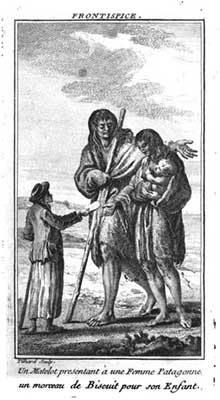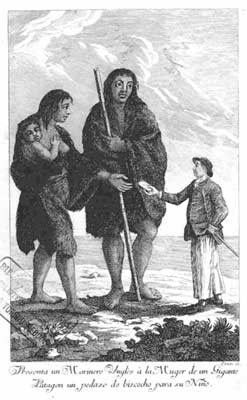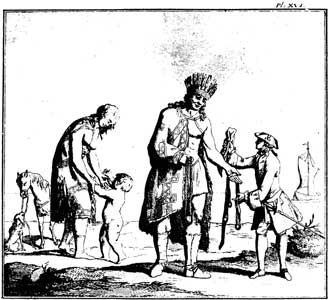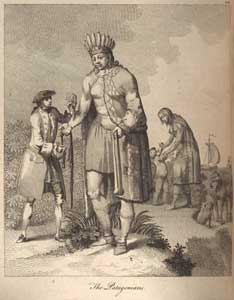Patagonia Bookshelf
Principal characters: Bougainville, Duclos-Guyot, Giraudais and Saint-Simon
The Patagonian Giants
 |
 |
|
| Un Matelot presentant a une Femme Patagonne un morceau de Biscuit pour son Enfant (Paris,1767) | Presenta un Marinero Inglés a la Muger de un Gigante Patagon un pedazo de bizcocho para su Niño (Madrid,1769) |
Tall Tales
Ever since the first Europeans traversed the Magellan Strait in 1520, reports had been received of the tall, robust inhabitants found along its Eastern coast, known today as the Aónikenk. Estimates of their height varied, but they were usually said to be tall, sometimes enormously so. For example, here is Ferdinand Magellan's chronicler, Antonio Pigafetta: [Pinkerton, 1812, pp. 314, 316]
and, later:
Stories such as these took a hold in the European public's fancy, and many were willing to believe in the existence of Giants in far-away Patagonia. After all, there was a strong literary tradition of giants and monsters, from classics such as Goliath and Polyphemus, through to the more "modern" Gargantua and Pantagruel, and the Brobdingnagians found by Gulliver in his travels. Professor Percy Adams's comprehensive study of this myth [Adams, 1962, Chapter 2], traces how in 18th century Britain this fascination was used to stir up a wave of Giant Fever and thereby provoked an irresponsible, self-serving hoax.
Eighteenth Century Travel Writing
As European voyages increased, so did the number of published first-hand reports of foreign lands, read by an increasingly literate population. One such example is Bougainville's account of a round-the-world voyage (1766-69), excerpted on this site. Two years earlier, Bougainville had founded a French colony on the Falkland Islands, accompanied by the priest Pernety. Upon his return to Europe in 1764, Pernety, who was also a naturalist, decided to publish his impressions of the voyage, and describe and illustrate what he had seen. This was a substantial task, and it was not until 1769 that a first publication took place.
Meanwhile, in the summer of 1766, the London press carried the sensational news that the Patagonian Giants really did exist. The evidence consisted of a report by an unnamed officer of the Royal Navy ship Dolphin, commander John Byron, recently returned from a round-the-world voyage. Interest mounted, and an anonymous book soon followed: its preface stated clearly: [Anonymous, 1768, Preface, 2nd page]
Ergo, the early tales of Patagonian Giants were indeed true. If any of the book's readers remained doubtful, the fanciful illustration (above) on the frontispiece "proved" the point.
These claims made international news, and translations of the book appeared rapidly in Paris, Madrid and Florence. Both public and scientific opinion were divided: some commentators made fun of the idea; others, more credulous, were convinced. Be that as it may, the Anonymous book sold well. Other publications with a Patagonian flavour shared in the popularity, including Byron's personal account of the Wager disaster (1741).
It is no surprise that the subject caught the attention of Pernety; the controversy was probably what prompted him to the add the reports of two of Bougainville's captains (Duclos-Guyot and Giraudais) to his own book. This was logical: both captains had recent, first-hand contact with the Patagonians, having observed them at close quarters while visiting the Magellan Strait in 1766, to collect timber for the new colony on the Falkland Islands. Nonetheless, it should be noted that at no time did Pernety meet the Aónikenk.
 |

|
|
| Patagonians (Pernety, Berlin,1769) | Patagonians (Pernety, London,1771) |
Pernety: Berlin Edition (1769)
Pernety was apparently convinced of the truth of the Anonymous book. When his own book went to press in Berlin in 1769, he chose to quote the section where Byron's men have their first, close view of the natives. Thus: [original text]
Ils aperçurent sur le rivage, des hommes d'une taille prodigieuse … Leur grandeur est si extraordinaire, que même assis ils étaient encore presque aussi hauts que le Commodore debout … Leur taille moyenne parut être d'environ huit pieds, & la plus haut de neuf pieds & plus.
Furthermore, Pernety criticised those people who, through vanity or pride, were not willing to accept this latest evidence. Now, his formal scientific illustrations had been augmented by an imaginative sketch (above, left) of a family of Patagonian Giants, accompanied by a diminutive, uniformed ship's officer.
In explaining the rationale for including the French captain's journals, Pernety stressed that they stayed longer with the Patagonians than the English did: the inference being that their accounts would be more accurate. Nonetheless, Pernetty's opinion about their giant stature is not supported by the journals. Here are two brief examples:
Pernety: Paris Edition (1770), London Edition (1771)
The subsequent edition of Pernety's book, printed in Paris in 1770, included the same quotation from the Anonymous book which he had used in the Berlin edition. This time, perhaps to give a more piquant flavour, he added the following incident, which he said was not included in the French edition: [original text]
Les femmes des Patagons caressèrent aussi le Commodore Byron; mais les politesses qu'elles lui firent essuyer, furent encore plus expressives; elles badinèrent, dit l'Historien Anglais, si sérieusement avec moi, que j'eus beaucoup de peine a m'en débarrasser.
This edition also contained a long Introduction, one of whose themes was the size of human beings in general, and of the Patagonians in particular. The writer recognized the reader's right to differ: [original text]
Je ne cherche a en imposer a personne; je sais que la plupart des Voyageurs qui traversèrent le détroit de Magellan dans le dix-septième siècle, ne virent dans la Patagonie que des hommes d'une taille ordinaire; ils en conclurent alors que leurs prédécesseurs avaient été des fourbes ou des visionnaires; les Sceptiques s'empressèrent d'adopter une opinion qui les dispensait d'être crédules, & l'existence des Géants fut bientôt mise au rang des "mensonges imprimés".
But, his closing remarks made clear that he accepted the Anonymous report: [original text]
Un Géant sur-tout ne fut jamais un monstre; la taille du Patagon, plus élevée du double que la nôtre; le volume de son corps huit fois plus considérable, n'occasionnent aucun désordre dans son économie organique. Qu'un homme de dix pieds s'unisse a une femme de même taille, voilà un peuple, & la nature est justifiée.
Blind conviction had triumphed over reason. Pernety simply ignored both of the Captains' eye-witness accounts.
An English translation of Pernety's book appeared in 1771; its Preface perpetuated the myth, repeating the 1769 wording. In addition, it included a new illustration, even more outrageous than the previous one. [Pernety, 1771, between pp. 272-273]
Cutting the myth down to size
Finally, in 1773, an official account of Byron's voyage was published; now a more credible picture emerged. The concept of enormous size, initially promoted and emphasized by the published illustrations (such as those presented here), was toned down. Still, there was a persistent impression of unusual height. For example:
Large yes; but not giants. It was time to lay that myth to rest. More than a century of subsequent measurements has given the average height for the Aónikenk man as around 6 feet (1.83m); and for the woman 5½ feet (1.68m) – table [Martinic, 1995, p. 41]. A further example /*/
Final Thoughts
So, why the continued tendency to exaggeration? Perhaps it was a combination of psychological factors – clothing, preconceptions, superstition and fear – compounded by the lower height of Europeans in earlier centuries. Now that the Aónikenk are extinct, we cannot see for ourselves; we must rely instead on historians and archaeologists.
As to why Pernety's book presented contradictory information, we will probably never know. Was his belief in the existence of giants stronger than the facts presented to him, or are we instead in the presence of a clever 18th-century marketing technique for selling more books? The reader must decide.
Duncan S. Campbell & Gladys Grace P.
First Edition, July 2012
/*/ (Note added 10-VIII-2012). Dr. Joseph Root, US Envoy, after visiting Punta Arenas in 1873, reported: « The average height of the men is five feet and a fraction over nine inches. The tallest one I found was six feet three inches and a half. They are broad-shouldered, with large, muscular bodies and limbs, and, like most large people, are well-disposed. Casimiro, a little larger than the average, measured five feet ten inches in height, and around the body under the arm forty-six inches and three-quarters; his feet, ten and three-quarter inches in length; head, twenty-three and a half inches in circumference. I measured no male head which was less than twenty-two inches, and only one female head as small as twenty-one inches around the crown. They are without doubt the largest race at the present time in the world. The women, while large, with broad shoulders, are not as tall in proportion as the men, not averaging quite five feet two inches. » [Papers relating to the Foreign Relations of the United States, 1873, Part I, Vol. I, p.115]